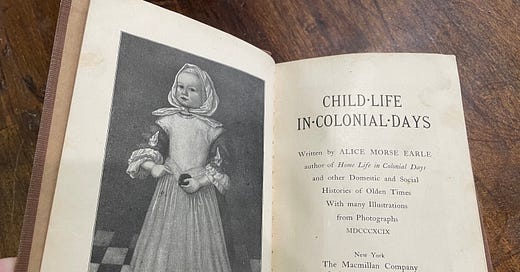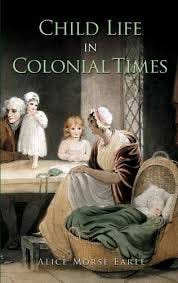Review of Child Life in Colonial Days by Alice Morse Earle
Alice Morse Earle’s Child Life in Colonial Days (1899) is a well-researched and engaging account of childhood in early America, drawing upon historical records, personal letters, and artifacts to recreate the experiences of colonial children. However, while Earle’s work is valuable for its detail, it ultimately presents a nostalgic and romanticized version of the past. Her portrayal of colonial childhood largely centers on white, Protestant children and fails to critically engage with the realities of class struggle, racial oppression, and patriarchal control. By applying a leftist analysis to this text, we can reveal the deeper structures of power that shaped childhood in colonial America, exposing the exploitative economic systems, gendered socialization, and racial hierarchies that Earle’s work either glosses over or omits entirely.
Earle’s book often frames colonial childhood as a time of moral discipline, community participation, and familial bonds. She emphasizes the simplicity of life, portraying children as industrious and obedient members of their households, contributing through chores, apprenticeships, and farm work. This view, however, largely aligns with the nostalgic tendencies of the late 19th century—a time when industrialization was rapidly transforming American society, leading many to long for an imagined past of close-knit rural communities and self-sufficiency. From a leftist perspective, this idealization obscures the economic and social realities of childhood labor. The romantic narrative of hardworking colonial children ignores the fact that many were subjected to long hours of grueling labor, often without access to education or leisure. The Puritan ethic of hard work and discipline, which Earle presents as a virtue, was also a means of enforcing obedience and preparing children to accept rigid hierarchies.
Earle describes the ways in which children contributed to household economies, whether through farm work, spinning wool, or assisting in shops. However, she does not critique how class position determined the level of hardship and opportunity available to children. Children from wealthy families had access to tutors, books, and better food, preparing them for leadership roles in colonial society. In contrast, children from poorer families often became indentured servants, working under harsh conditions for years to "pay off" their family's debts. Even more marginalized were enslaved Black children, whom Earle barely mentions, who were born into a system that saw them as property rather than people, condemning them to a lifetime of forced labor.
A Marxist analysis reveals how childhood labor in the colonial period was a crucial part of the economic system, particularly for the ruling elite. The division of labor ensured that wealthier children would inherit power, while poorer children were trapped in cycles of economic dependence. The system also reinforced capitalist ideals of individual labor as a moral duty, legitimizing inequality by framing it as the natural order of things.
One of the book’s most glaring omissions is its near-total silence on the experiences of enslaved and Indigenous children. This absence is not accidental—it reflects the dominant historiographical trends of Earle’s time, which often erased or minimized the brutal realities of colonialism and slavery. Enslaved Black children were subjected to forced labor from a young age, often separated from their families, and denied education. Unlike white children, their labor was not framed as "character-building" but as an economic necessity for the ruling class.
Indigenous children faced displacement, forced assimilation, and violence at the hands of colonists. Many were placed in missionary schools, where they were stripped of their language and culture in an attempt to "civilize" them. Earle’s failure to acknowledge these histories contributes to the myth of colonial innocence, portraying colonial society as a largely harmonious and orderly system rather than one built on the exploitation of marginalized groups. A leftist reading demands that we recognize these erasures and center the voices of those who were deliberately excluded from the historical record.
Earle provides rich details about the gendered expectations placed on colonial children. Girls were trained in domestic tasks—sewing, cooking, and childcare—while boys were taught farming, craftsmanship, or trade. However, she does not question how these rigid roles served to maintain patriarchal control over women’s labor. A feminist Marxist analysis, such as those offered by theorists like Silvia Federici, highlights how the nuclear family functioned as an economic unit designed to control and exploit women’s unpaid labor.
In colonial society, women were expected to remain within the domestic sphere, producing and raising children who would continue to serve the colonial economy. Girls were prepared for marriage and motherhood, their primary role being to provide unpaid domestic labor, while boys were given more opportunities for education and economic advancement, reinforcing male dominance in both the household and public life. By failing to critique these structures, Earle’s work reinforces the idea that gendered divisions of labor were natural or even beneficial, rather than a means of maintaining economic and social control.
Earle describes colonial schooling in detail, emphasizing the use of religious texts like the New England Primer to instill moral discipline. While she views this education as a positive influence, a leftist critique reveals its deeper function as a mechanism of ideological control. The colonial education system was not designed to foster critical thinking but to enforce obedience and religious conformity. Children were taught to fear sin, respect authority, and accept their social roles without question.
Althusser’s concept of ideological state apparatuses helps explain how schools functioned to reproduce colonial social structures, ensuring that each generation internalized the values needed to maintain the ruling order. Furthermore, access to education was deeply unequal. Wealthy white boys were educated in classical subjects, preparing them for leadership positions. Poor children received only the most basic literacy and numeracy skills, enough to function within a laboring class but not enough to challenge their status. Enslaved and Indigenous children were largely denied education or subjected to programs aimed at cultural erasure. By failing to critique these inequalities, Earle reinforces a sanitized view of colonial schooling that ignores its role in perpetuating social hierarchies.
Child Life in Colonial Days is a well-researched and engaging historical account, but it must be read critically. While it provides valuable insight into the material culture and daily routines of colonial children, it ultimately presents a whitewashed and nostalgic view of the past. A leftist analysis reveals the deeper realities that Earle overlooks. Child labor was a tool of economic exploitation, reinforcing class hierarchies. Racialized oppression shaped childhood, with Indigenous and enslaved children facing brutal treatment that Earle ignores. Gender roles ensured the continued subjugation of women, training girls for unpaid domestic labor. Education functioned as a means of ideological control, rather than a tool for liberation.





